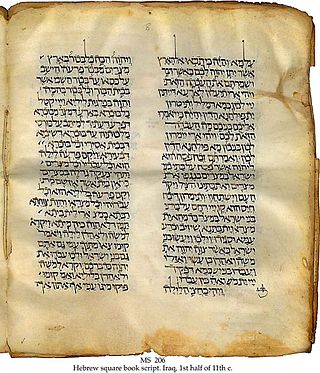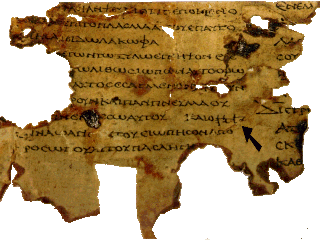Related Research Articles

The Bible is a collection of religious texts or scriptures, some, all, or a variant of which are held to be sacred in Christianity, Judaism, Samaritanism, Islam, the Baha'i Faith, and many other Abrahamic religions. The Bible is an anthology, a compilation of texts of a variety of forms, originally written in Hebrew, Aramaic, and Koine Greek. These texts include instructions, stories, poetry, and prophecies, among other genres. The collection of materials that are accepted as part of the Bible by a particular religious tradition or community is called a biblical canon. Believers in the Bible generally consider it to be a product of divine inspiration, but the way they understand what that means and interpret the text varies.

The Septuagint, sometimes referred to as the Greek Old Testament or The Translation of the Seventy, and often abbreviated as LXX, is the earliest extant Greek translation of the Hebrew Bible from the original Hebrew. The full Greek title derives from the story recorded in the Letter of Aristeas to Philocrates that "the laws of the Jews" were translated into the Greek language at the request of Ptolemy II Philadelphus by seventy-two Hebrew translators—six from each of the Twelve Tribes of Israel.

A targum was an originally spoken translation of the Hebrew Bible that a professional translator would give in the common language of the listeners when that was not Biblical Hebrew. This had become necessary near the end of the first century BC, as the common language was Aramaic and Hebrew was used for little more than schooling and worship. The translator frequently expanded his translation with paraphrases, explanations and examples, so it became a kind of sermon.

The Masoretic Text is the authoritative Hebrew and Aramaic text of the 24 books of the Hebrew Bible (Tanakh) in Rabbinic Judaism. The Masoretic Text defines the Jewish canon and its precise letter-text, with its vocalization and accentuation known as the mas'sora. Referring to the Masoretic Text, masorah specifically means the diacritic markings of the text of the Jewish scriptures and the concise marginal notes in manuscripts of the Tanakh which note textual details, usually about the precise spelling of words. It was primarily copied, edited, and distributed by a group of Jews known as the Masoretes between the 7th and 10th centuries of the Common Era (CE). The oldest known complete copy, the Leningrad Codex, dates from the early 11th century CE.

The Samaritan Pentateuch, also called the Samaritan Torah, is the sacred scripture of the Samaritans. Written in the Samaritan script, it dates back to one of the ancient versions of the Torah that existed during the Second Temple period, and constitutes the entire biblical canon in Samaritanism.

The Dead Sea Scrolls, also called the Qumran Caves Scrolls, are a set of ancient Jewish manuscripts from the Second Temple period. They were discovered over a period of 10 years, between 1946 and 1956, at the Qumran Caves near Ein Feshkha in the West Bank, on the northern shore of the Dead Sea. Dating from the 3rd century BCE to the 1st century CE, the Dead Sea Scrolls include the oldest surviving manuscripts of entire books later included in the biblical canons, along with extra-biblical and deuterocanonical manuscripts from late Second Temple Judaism. At the same time, they cast new light on the emergence of Christianity and of Rabbinic Judaism. Almost all of the 15,000 scrolls and scroll fragments are held in the Shrine of the Book at the Israel Museum, located in the city of Jerusalem. The Israeli government's custody of the Dead Sea Scrolls is disputed by Jordan and the Palestinian Authority on territorial, legal, and humanitarian grounds—they were mostly discovered following the Jordanian annexation of the West Bank and were acquired by Israel after Jordan lost the 1967 Arab–Israeli War—whilst Israel's claims are primarily based on historical and religious grounds, given their significance in Jewish history and in the heritage of Judaism.

The Aleppo Codex is a medieval bound manuscript of the Hebrew Bible. The codex was written in the city of Tiberias in the tenth century CE under the rule of the Abbasid Caliphate, and was endorsed for its accuracy by Maimonides. Together with the Leningrad Codex, it contains the Aaron ben Moses ben Asher Masoretic Text tradition.

The Nash Papyrus is a collection of four papyrus fragments acquired in Egypt in 1902, inscribed with a Hebrew text which mainly contains the Ten Commandments and the first part of the Shema Yisrael prayer, in a form that differs substantially from the later, canonical Masoretic text and is in parts more similar to the chronologically closer Septuagint. It has been suggested that the text might have been the daily worship of a Jew living in Egypt at the time. The fragments comprise a single sheet and are not part of a scroll. The papyrus is of unknown provenance, although it is allegedly from Fayyum. The text was first described by Stanley A. Cook in 1903. Though dated by Cook to the 2nd century CE, subsequent reappraisals have pushed the date of the fragments back to about 150–100 BCE. The papyrus was by far the oldest Hebrew manuscript fragment known at that time, before the discovery of the Dead Sea Scrolls in 1947.

The Song of the Sea is a poem that appears in the Book of Exodus of the Hebrew Bible, at Exodus 15:1–18. It is followed in verses 20 and 21 by a much shorter song sung by Miriam and the other women. The Song of the Sea was reputedly sung by the Israelites after their crossing the Red Sea in safety, and celebrates their freedom after generations of slavery and oppression by the Egyptians.
Hebrew Bible English translations are English translations of the Hebrew Bible (Tanakh) according to the Masoretic Text, in the traditional division and order of Torah, Nevi'im, and Ketuvim. Most Jewish translations appear in bilingual editions (Hebrew–English).

The Hebrew alphabet is a script that the Aramaic alphabet was derived from during the Persian, Hellenistic and Roman periods. It replaced the Paleo-Hebrew alphabet which was used in the earliest epigraphic records of the Hebrew language.
The Jerusalem Crown is a printed edition of the Tanakh printed in Jerusalem in 2001, and based on a manuscript commonly known as the Aleppo Crown). The printed text consists of 874 pages of the Hebrew Bible, two pages setting forth both appearances of the Ten Commandments each showing the two different cantillations—for private and for public recitation, 23 pages briefly describing the research background and listing alternative readings, a page of the blessings—the Ashkenazic, Sephardic and Yemenite versions—used before and after reading the Haftarah, a 9-page list of the annual schedule of the Haftarot readings according to the three traditions.
Biblical Hebrew orthography refers to the various systems which have been used to write the Biblical Hebrew language. Biblical Hebrew has been written in a number of different writing systems over time, and in those systems its spelling and punctuation have also undergone changes.
4Q41 or 4QDeuteronomyn, also known as the All Souls Deuteronomy, is a Hebrew Bible manuscript from the first century BC containing two passages from the Book of Deuteronomy. Discovered in 1952 in a cave at Qumran, near the Dead Sea, it preserves the oldest existing copy of the Ten Commandments.

The Greek Minor Prophets Scroll from Nahal Hever is a Greek manuscript of a revision of the Septuagint dated to the 1st century BC and the 1st century CE. The manuscript is kept in the Rockefeller Museum in Jerusalem. It was first published by Dominique Barthélemy in 1963. The Rahlfs-Siglum is 943.
Ancient Hebrew writings are texts written in Biblical Hebrew using the Paleo-Hebrew alphabet before the destruction of the Second Temple in 70 CE.
The Great Psalms Scroll, also referred to as 11Q5, is the most substantial and well preserved manuscript of Psalms of the thirty-seven discovered among the Dead Sea Scrolls in the Qumran caves. It is one of six Psalms manuscripts discovered in Cave 11.

Jeremiah 30 is the thirtieth chapter of the Book of Jeremiah in the Hebrew Bible or the Old Testament of the Christian Bible. It is numbered as Jeremiah 37 in the Septuagint. This book contains prophecies attributed to the prophet Jeremiah, and is one of the Books of the Prophets. The Jerusalem Bible refers to chapters 30 and 31 as "the Book of Consolation", and Lutheran theologian Ernst Hengstenberg calls these two chapters "the triumphal hymn of Israel’s salvation". This chapter contains the promises to restoration.

Paleo-Hebrew Leviticus Scroll, known also as 11QpaleoLev, is an ancient text preserved in one of the Qumran group of caves, and which provides a rare glimpse of the script used formerly by the Israelites in writing Torah scrolls during pre-exilic history. The fragmentary remains of the Torah scroll is written in the Paleo-Hebrew script and was found stashed away in cave no. 11 at Qumran, showing a portion of Leviticus. The scroll is thought to have been penned by the scribe between the late 2nd century BCE to early 1st century BCE, while others place its writing in the 1st century CE.
References
- ↑ Sanders, Paul (2014-01-01). "The Ashkar-Gilson Manuscript: Remnant of a Proto-Masoretic Model Scroll of the Torah". Journal of Hebrew Scriptures . 14. doi: 10.5508/jhs.2014.v14.a7 . ISSN 1203-1542.
- ↑ Charlesworth, James H. (2015). "Ashkar Manuscript 2: Introducing a Phenomenal New Witness to the Bible" (PDF). Israel Museum Studies in Archaeology. 7: 66–69.
- ↑ "What Is the Oldest Hebrew Bible?". Biblical Archaeology Society. 2021-01-10. Retrieved 2021-08-14.
- ↑ McDonald, Amy (2010-03-05). "Ashkar-Gilson Manuscript in the News". The Devil's Tale. Retrieved 2021-08-14.
- ↑ Engel, Edna; Mishor, Mordechay (2015). "An Ancient Scroll of the Book of Exodus: The Reunion of Two Separate Fragments" (PDF). Israel Museum Studies in Archaeology. 7: 24–61.
- ↑ "Fragments of 1,300-year-old Torah scroll reunited | Jerusalem Dispatch" . Retrieved 2021-08-14.
- ↑ Veintrob, Mordechai (2019-04-01). "More fragments of early Torah scroll come to light". Genizah Fragments. 77: 1–2. Retrieved 2024-02-25.
- ↑ Sanders, Paul (2024). "Rediscovered Fragments Shed New Light on a Proto-Masoretic Torah Scroll". Journal of Hebrew Scriptures . 23: 1–22. doi: 10.5508/jhs29630 . ISSN 1203-1542.